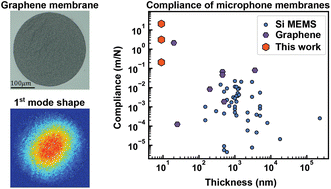Ultra-sensitive graphene membranes for microphone applications†
Abstract
Microphones exploit the motion of suspended membranes to detect sound waves. Since the microphone performance can be improved by reducing the thickness and mass of its sensing membrane, graphene-based microphones are expected to outperform state-of-the-art microelectromechanical (MEMS) microphones and allow further miniaturization of the device. Here, we present a laser vibrometry study of the acoustic response of suspended multilayer graphene membranes for microphone applications. We address performance parameters relevant for acoustic sensing, including mechanical sensitivity, limit of detection and nonlinear distortion, and discuss the trade-offs and limitations in the design of graphene microphones. We demonstrate superior mechanical sensitivities of the graphene membranes, reaching more than 2 orders of magnitude higher compliances than commercial MEMS devices, and report a limit of detection as low as 15 dBSPL, which is 10–15 dB lower than that featured by current MEMS microphones.



 Please wait while we load your content...
Please wait while we load your content...